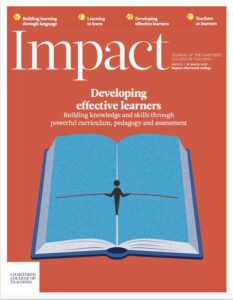Speaking up: The importance of oracy in teaching and learning

How can teachers support oracy in their classrooms?
Will Millard
Speech and communication lies at the heart of classroom practice. It is the predominant way in which teachers provide instruction and support to their students and is central to how most students engage with the curriculum. This article examines how teachers can support oracy in the classroom, drawing on research commissioned by Voice 21, an organisation working with UK schools to support the teaching of spoken communication skills, and undertaken by LKMco, a think tank working across the education and policy sectors.
What is ‘oracy’?
Oracy can be seen as an outcome, whereby students learn to talk confidently, appropriately and sensitively. This article focuses on oracy as a process, whereby students learn through talk, deepening their understanding through dialogue with their teachers and peers (Alexander, 2012). Oracy involves teachers and their students thinking carefully and deliberately about the sorts of spoken language they are using, and this will vary across subjects and with different age groups. Different types of talk will be appropriate at different points in the learning cycle, and Robin Alexander outlines five key types of ‘teaching talk’ (Alexander, 2008):
- Rote: imparting knowledge by getting students to repeat key pieces of information to impart facts, ideas and routines.
- Recitation: using questions to test students’ knowledge and understanding, to check students’ progress, and stimulate recall.
- Instruction: telling students what to do and explaining key facts, principles or processes in order to transmit information.
- Discussion: encouraging the exchange of ideas within a class, to share information.
- Dialogue: using structured questions and discussion, helping students deepen understanding of key knowledge, principles and processes.
What are the benefits of developing teachers’ and students’ oracy?
Developing classroom talk has a wide range of benefits on students’ outcomes during school, and beyond. In particular, structured dialogue during lessons, where students are encouraged to participate verbally and given space and time to reflect upon and discuss complex ideas, is linked with:
- Cognitive gains, including improved results in English, maths and science, the retention of subject-specific knowledge, and ‘transference’ of reasoning skills across subject areas (Jay et al., 2017);
- Personal and social gains, including attitudes towards learning, enhanced self-esteem and self-confidence, and a reduction in anxiety (Hanley P et al., 2015); (Gorard et al., 2015), and;
- Civic engagement and empowerment, increasing children and young people’s ability to debate issues, while also increasing understanding about social issues and ability to manage differences with others (Nagda and Gurin, 2007).
Recent Education Endowment Foundation-funded evaluations indicate raising the quality and rigour of classroom talk has a range of positive academic, personal and social outcomes, in particular for children eligible for free school meals (Gorard et al., 2015); (Hanley P et al., 2015), and in terms of teachers’ confidence (Jay et al., 2017).
How do teachers use oracy?
Teachers recognise the importance of developing oracy in their lessons. Drawing on the results of a poll of over 900 teachers, 11 interviews with oracy experts, and 26 interviews and focus groups with teachers, school leaders and students in thirteen schools, LKMco’s research with Voice 21 highlights work taking place from the Early Years up to post-16 provision, in mainstream and special schools, and in the state and independent sectors (Millard and Menzies, 2016).
In the poll, over half of teachers said they model the sorts of spoken language they expect of their students, set expectations for their students’ oracy, and initiate pair or group activities in most of their lessons. Early Years and primary teachers, and essay-based subject teachers, tend to initiate such activities with greater regularity than their colleagues.
Exploring the strategies used in classrooms to support students’ language learning, Dockrell et al. (Dockrell et al., 2012) find teachers use some strategies more regularly than others. Their analysis of language learning environments, opportunities and interactions in 101 Reception and Key Stage 1 classes using the Communication Supporting Classroom Observation Tool (CSCOT) found:
- Small group work was the most common language learning opportunity across the year groups studied;
- The use of gesture and open questions were among those used regularly by teachers, while;
- The encouragement of new words, turn taking and listening skills were among the interactions observed less regularly.
One particular type of verbal interaction that features heavily in whole class teaching is teacher-led recitation, in which the teacher asks a question, a student responds, and the teacher evaluates their answer. Studies of classroom discourse suggest this form of interaction is highly prevalent throughout schooling, and that the questions themselves tend to seek predictable answers. While this has its uses, it is of limited use in prompting students to explore more elaborate ideas.
What are the barriers to better oracy?
Despite the importance teachers place on developing students’ oracy, LKMco’s research found there are barriers to them doing so (Millard and Menzies, 2016). A lack of time is the most common, cited by 31% of teachers. A quarter of respondents talked about avoiding oracy-based activities for fear of making shy or under-confident students uncomfortable. Consequently, the students who might potentially benefit most from such activities can miss out. Another common concern, cited by one in five respondents, is that discussion and dialogue will lead to disruption, prompting some to avoid such activities altogether.
An additional challenge faced by teachers and schools wanting to develop and extend oracy is that there is ‘nothing to show for it’. Interviewees felt this was a response to ‘high stakes’ accountability, wherein teachers feel under pressure to ensure students produce lots of writing.
How can teachers and schools overcome these barriers?
Individual teachers, groups of teachers, and whole schools can work to support their students’ oracy. Teachers can:
- Set clear ‘ground rules’ for talk during lessons (for example, by clarifying how and when students can contribute to class discussions, and what ‘active listening’ involves). Whole schools can also set expectations in this regard, such as in terms of how students should speak to their peers, and to staff and visitors.
- Model the talk they expect from students (in terms of tone and etiquette, as well as vocabulary and content).
- Ask great questions, encouraging different sorts of thought processes at different stages in the learning process. For example, teachers might prompt students to recall information at first, before then encouraging a deeper exploration of ideas.
- Scaffold students’ interactions and responses during lessons, for instance, by using sentence starters.
- Provide students with feedback on both what they say, and how they say it.
- Seek and give colleagues feedback on their classroom talk during development lesson observations.
Teachers at Eastwood Primary School in Keighley, for example, make video recordings of students at work, and then help the children evaluate their interactions in lessons. Riz Saleem, a year 6 teacher, said students reflect both on the content itself and on how they interact with one another. They might say, for example, “‘Miss, we don’t think we made eye contact with each other, and we think we need to…build on each other’s ideas.” This feedback is then used to inform future class work. Staff at the school said this has helped the students – many of whom speak English as an additional language – develop their confidence and skills as communicators.
Teachers should ensure their expectations of students’ ability to engage in dialogue are challenging but reasonable. Talking Point, a website run by the children’s communication charity I CAN, has a progress checker that teachers working with students of all ages may find helpful when establishing expectations for classroom talk (Talking Point, 2018).
Promoting oracy in the classrooms has the potential to help diversify and strengthen pedagogy, and deepen learning.
Learning through talk: Deepening subject knowledge through oracy
Amy Gaunt
What could an oracy-rich classroom look like and how could it support students to refine their subject knowledge and develop their understanding?
At School 21, in Stratford, East London, teachers provide students with opportunities to learn, both to and through talk. In practice, this means that students are encouraged to develop and revise their understanding through sustained and productive dialogue with their peers. When engaging in discussion, for example, students must have a system for turn-taking, and they must ensure that everyone has a chance to contribute and that when somebody speaks, their ideas are respected. Introducing ‘ground rules for talk’, as advocated by Dawes et al. (Dawes et al., 2004) has been particularly effective at teaching students the conventions of group talk and ensuring that everybody’s voice is valued.
To ensure that the contributions students make to group discussions improve their reasoning and develop their understanding, students are also taught a number of ‘talk moves’ or ‘roles’. These encourage students to develop and interact with their own and other’s ideas by, for example, challenging, clarifying or probing a group member’s idea. Students are also taught to build or elaborate on each other’s ideas, rather than merely stating their own thoughts with no relation to what has been said previously. They are taught when to introduce a new line of enquiry or summarise a discussion and are encouraged to consider how these ‘moves’ can help further their thinking as a group.
The Oracy Framework, developed in conjunction with teachers at School 21 and Cambridge University, provides a lens through which to view the oracy skills required to engage in effective group talk, and can be an effective way of framing the teaching of these skills (Mercer N et al., 2017); see https://impact.chartered.college/article/mercer-identifying-assessing-student-spoken-language-skills/)
Teaching students the oracy skills they require to learn effectively throughtalk ensures that group talk develops both students’ thinking and understanding. Anna Kyrk, Head of Curriculum at School 21, has developed a talk-rich approach to teaching Year 7 science, which provides students with plenty of opportunities to develop their scientific subject knowledge and understanding. She explains one strategy that has been particularly useful:
‘Representing a scientific concept as a story, through pictures, has been a really effective way of immersing students in big scientific concepts. The students decode the stories through discussion in groups. I then layer in the key vocabulary needed to identify the processes of complex ideas such as genetic mutation, variation and natural selection. By the end of a 40-minute session, students are able to explain these processes, using the story to support their explanations. My role is to listen in, to guide the discussion and move the students’ understanding on through talk and effective questioning.
Becoming an oracy teacher has changed my practice significantly. In our classroom, I am not the holder of knowledge and my job is not to ‘fill up’ the students. We talk to discover, then we communicate what we have found out, backed up by the subject knowledge and key vocabulary that we have developed through talk. We are explorers together.’
References
This article was published in February 2018 and reflects the terminology and understanding of research and evidence in use at the time. Some terms and conclusions may no longer align with current standards. We encourage readers to approach the content with an understanding of this context.











